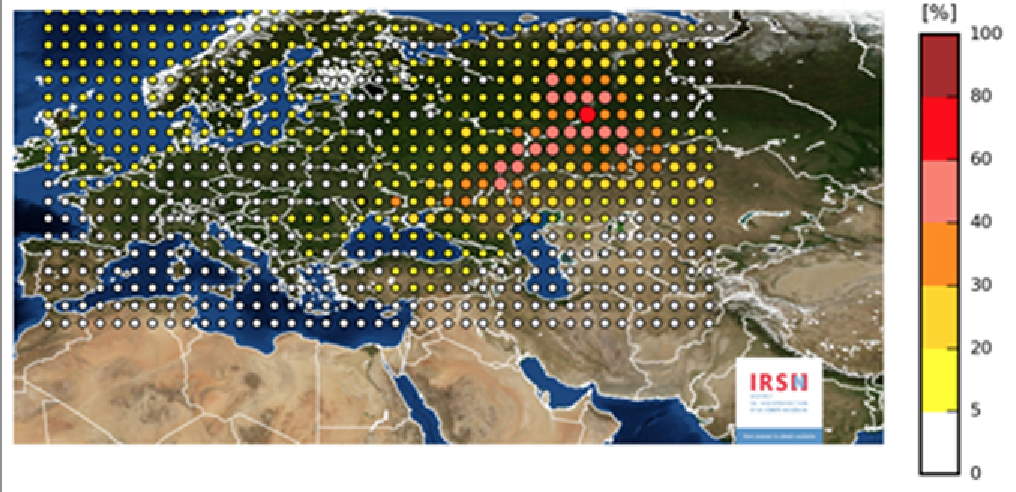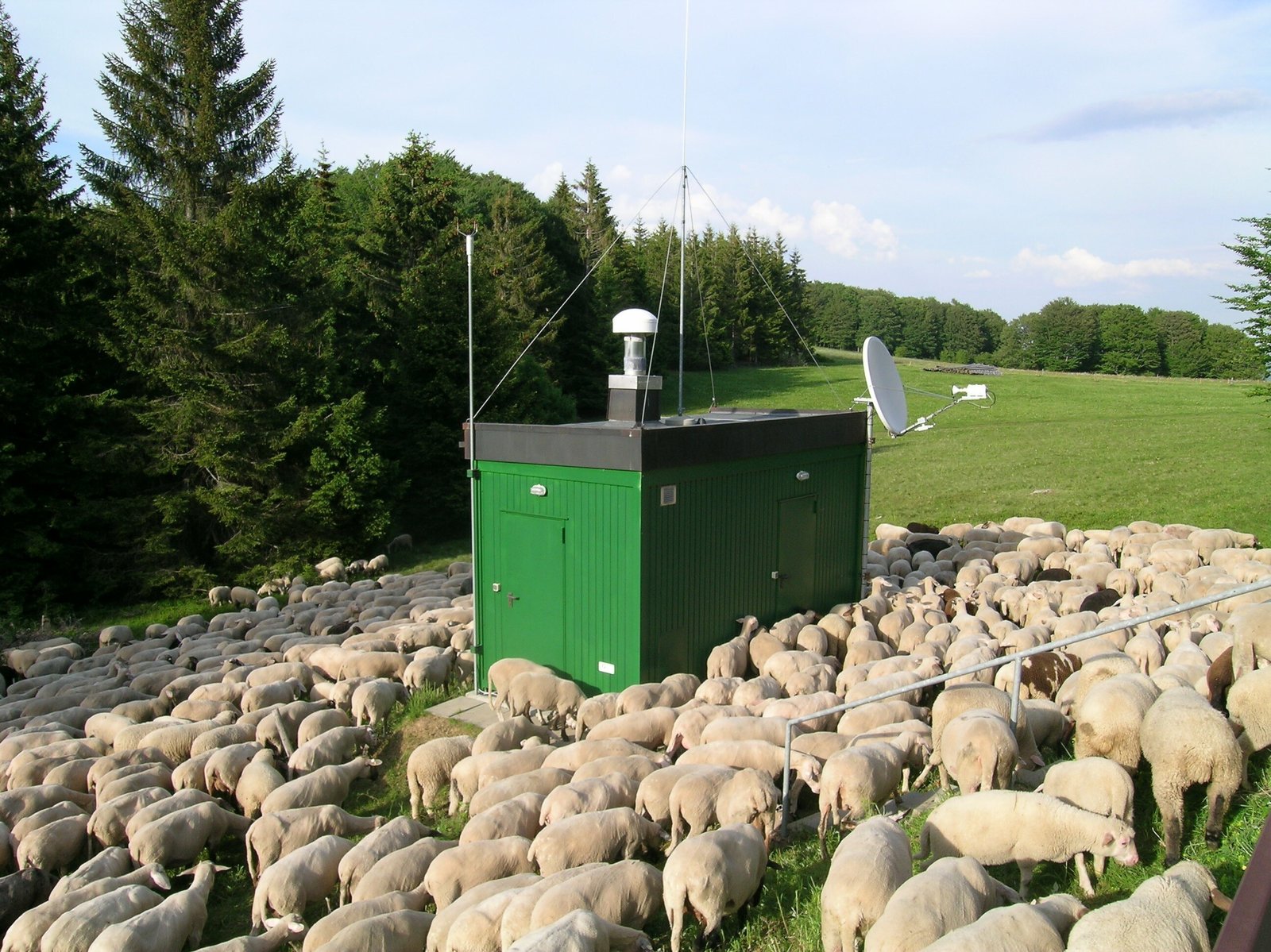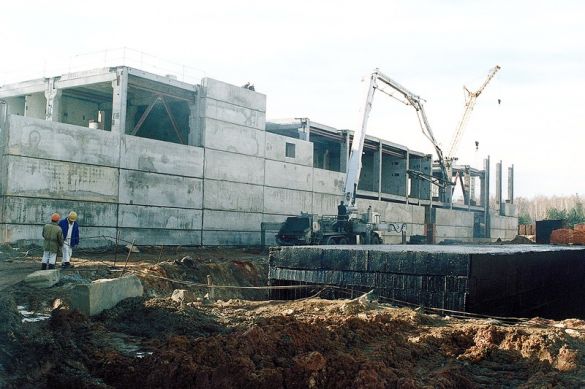Radiation Cloud Over Europe, Not ‘Harmless’ to Those near Unknown Source, Nuclear Expert Says

(EnviroNews World News) — An airborne plume of radioactive ruthenium 106 from a nuclear accident was detected “in the atmosphere of the majority of European countries,” from late September through mid-October, according to France’s Radioprotection and Nuclear Safety Institute (IRSN) — but the source is still unknown. As of November 10, 2017, the manmade element has been identified in at least 28 countries.
While many news agencies are calling the cloud “harmless” and reporting the good news — that radiation levels are low and that no health consequences have been observed — radiation experts tell EnviroNews the scene may not be so peachy at ground zero where the release occurred. The question is: where exactly is ground zero?
In a report, the IRSN used wind and weather patterns, coupled with readouts from radiation monitoring stations throughout Europe, to deduce the “most plausible zone of release lies between the [Volga River] and the [Ural Mountains].” According to NPR, Jean-Christophe Gariel, Director for Health at the IRSN, said, the plume “has been traced to somewhere along the Russia-Kazakhstan border.”
“Russian authorities have said they are not aware of an accident on their territory,” Jean-Marc Peres, Director at the IRSN, told Reuters, adding that he had not yet been in contact with Kazakh officials.
“Whoever released it ain’t talking,” said nuclear expert and whistleblower Arnie Gundersen to EnviroNews, in an email interview. “It’s kind of like passing gas in church. Everybody knows it happened but no one is admitting to be the source!” Gundersen, of Fairewinds Associates, is a nuclear engineer and former nuclear power plant operator, who was also CNN‘s on-air expert during the three-reactor meltdown at Fukushima Daiichi.
What is known is that the release did not emanate from a nuclear power reactor meltdown. If that were the case, the cloud would have been loaded with many other radionuclides generated during meltdowns. The IRSN said the release likely came from a “nuclear fuel treatment site or centre for radioactive medicine,” according to Reuters.
The IRSN also wrote in its report, “there has been no impact on human health or the environment,” and many news agencies have since regurgitated this assertion in their reporting. But this is a difficult statement. The gestation period for the carcinogenic and mutagenic health consequences from even low-level radiation exposure is very long, and medical maladies may take decades to unfurl. The effects of exposure to ionizing radiation can also be multigenerational, deforming the genes of unborn children and grandchildren, predisposing them to medical conditions before they are born.
According to Gundersen, what the IRSN failed to mention in its report, is that while radiation levels over Europe may be “very low,” that may not be the case near the mystery facility where the accident occurred. “The ruthenium 106 concentrations at the detectors in Europe are [quite] low and these are very sensitive detectors,” Gundersen explained to EnviroNews. “That said, the concentration near the release point is likely quite high, and is not ‘harmless’ to those who are close by. That is why pinpointing the location of the release is so important,” Gundersen continued. The esteemed industry expert also noted that the readings in the INRS report “are from mid-October” and that those releases are “supposedly over now.”

NPR concurred with Gundersen’s assessment, reporting, “modeling suggests that any people within a few kilometers of the release — wherever it occurred — would have needed to seek shelter to protect themselves from possible radiation exposure.” The IRSN also added that if a similar incident would have occurred within French borders, it would have required evacuation for an area with a radius of several kilometers.
As EnviroNews has reported in the past, air pollution concentrates most abundantly near its source. In the case of heavy metals and radioactive isotopes, larger particles with more mass, fall out faster and closer to the point of origin, whereas smaller particles can be carried on wind currents for hundreds or thousands or miles, falling to Earth wherever wind and precipitation carry them. The smaller and more vaporous the particle, the farther it can fly. Myriad finely disintegrated radioactive isotopes from both Chernobyl and Fukushima circled the globe for weeks following those accidents, and it has been stated by experts that to varying degrees, virtually every person on Earth has a piece of Fukushima and Chernobyl lodged inside them. Most human bodies also harbor the radioactive footprint from bomb testing — radiation that is still falling out and blowing around to this day.
Ruthenium 106 is a transuranic isotope created in nuclear reactors. The element is not present in nature. It has a half-life of 373 days, meaning it takes about 10 years for it to decay away after it is born as a byproduct of the nuclear fission process.
“It’s an unusual isotope,” Anders Ringbom, Research Director of the Swedish Defence Research Agency, told NPR. “I don’t think we have seen it since the Chernobyl accident.” The Swedish Defence Research Agency is the organization that conducts radiation monitoring for that country.
Multiple nuclear facilities exist in the region in question, the most noteworthy of which is the massive Mayak Production Association — a plant used extensively during the Cold War to recondition nuclear fuel into bomb material. Mayak has raised eyebrows because the site has been the source of multiple past disasters, including a massive explosion in 1957 “that rivaled the nuclear meltdowns at Fukushima and Chernobyl,” according to NPR. Still, Russian authorities are yet to acknowledge any accidental releases within their borders.

If the Russians aren’t owning the accident and the Kazakhs aren’t talking, the question is: what’s next? Gundersen pointed out the imperative task of locating the source of the incident. It would seem that only then can an assessment be made of the true “impact on human health or the environment.”
RELATED:
Study: Radioactive Hot Particles Still Afloat Throughout Japan Six Years After Fukushima Meltdowns
(EnviroNews DC News Bureau) – Radioactive particles of uranium, thorium, radium, cesium, strontium, polonium, tellurium and americium are still afloat throughout Northern Japan more than six years after a tsunami slammed into the Fukushima Daiichi Power Plant causing three full-blown nuclear meltdowns. That was the conclusion reached by…
YOU MAY ALSO LIKE:
NUCLEAR POWER IN OUR WORLD TODAY — 15-PT. ENVIRONEWS MINI-SERIES FEATURING ARNIE GUNDERSEN:
Dams Place 39 US Reactors in Line of Fire Says Nuclear Expert – Fukushima-Style Scenarios Possible (Pt. 6)
(EnviroNews DC News Bureau) – Editor’s Note: The following news piece represents the sixth in a 15-part mini-series titled, Nuclear Power in Our World Today, featuring nuclear authority, engineer and whistleblower Arnie Gundersen. The EnviroNews USA special encompasses a wide span of topics, ranging from Manhattan-era madness to…
Should GE’s Mark 1 Nuclear Reactor Be Recalled Worldwide Like a Faulty Unsafe Automobile? (Pt. 5)
(EnviroNews DC Bureau) – Editor’s Note: The following news piece represents the fifth in a 15-part mini-series titled, Nuclear Power in Our World Today, featuring nuclear authority, engineer and whistleblower Arnie Gundersen. The EnviroNews USA special encompasses a wide span of topics, ranging from Manhattan-era madness to the…
How DOE Incentivized Executives at Hanford To Sweep a Plutonium Leak Under The Rug (Pt. 4)
(EnviroNews DC News Bureau) – Editor’s Note: The following news piece represents the forth in a 15-part mini-series titled, Nuclear Power in Our World Today, featuring nuclear authority, engineer and whistleblower Arnie Gundersen. The EnviroNews USA special encompasses a wide span of topics, ranging from Manhattan-era madness to…
St. Louis’ West Lake Landfill: A Runaway, Ticking, Nuclear Time Bomb That Has Residents Terrified (Pt. 3)
(EnviroNews DC News Bureau) – Editor’s Note: The following news piece represents the third in a 15-part mini-series titled, Nuclear Power in Our World Today, featuring nuclear authority, engineer and whistleblower Arnie Gundersen. The EnviroNews USA special encompasses a wide span of topics, ranging from Manhattan-era madness to…
Bill Gates’ Plutonium Pipe Dream: Convert Mountains of Depleted Uranium at Paducah to Power Earth for Centuries (Pt. 2)
(EnviroNews DC Bureau) – Editor’s Note: The following news piece represents the second in a 15-part mini-series titled, Nuclear Power in Our World Today, featuring nuclear authority, engineer and whistleblower Arnie Gundersen. The EnviroNews USA special encompasses a wide span of topics, ranging from Manhattan-era madness to the…
The Dirty Deadly Front End of Nuclear Power – 15,000 Abandoned Uranium Mines (Pt. 1)
(EnviroNews DC Bureau) – Editor’s Note: The following news piece represents the first in a 15-part mini-series titled, Nuclear Power in Our World Today, featuring nuclear authority, engineer and whistleblower Arnie Gundersen. The EnviroNews USA special encompasses a wide span of topics, ranging from Manhattan-era madness to the…
2 thoughts on “Radiation Cloud Over Europe, Not ‘Harmless’ to Those near Unknown Source, Nuclear Expert Says”
Leave a Reply
You must be logged in to post a comment.
FILM AND ARTICLE CREDITS
- Emerson Urry - Journalist, Author


![Leading the Charge for America’s Wild Horses on Capitol Hill: NBA/NFL Celeb. Bonnie-Jill Laflin: ‘[Politics] won’t stop us from fighting’](https://cf-images.us-east-1.prod.boltdns.net/v1/static/1927032138001/f46b2158-cead-47f0-ab44-4b027059411a/4e4afcf2-937d-4a9d-acba-1b82e2efd4c6/160x90/match/image.jpg)



Some guys went flying through that cloud!! Check what they found on https://youtu.be/nV7uNMQ9AgI